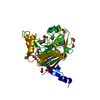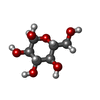[English] 日本語
 Yorodumi
Yorodumi- PDB-8tde: Structure of glucose bound Bacteroides thetaiotaomicron 3-Keto-2-... -
+ Open data
Open data
- Basic information
Basic information
| Entry | Database: PDB / ID: 8tde | ||||||
|---|---|---|---|---|---|---|---|
| Title | Structure of glucose bound Bacteroides thetaiotaomicron 3-Keto-2-hydroxy-glucal-hydratase BT2 | ||||||
 Components Components | Probable secreted glycosyl hydrolase | ||||||
 Keywords Keywords |  ISOMERASE / ISOMERASE /  Hydratase / GH16-like Hydratase / GH16-like | ||||||
| Function / homology | 3-keto-disaccharide hydrolase / 3-keto-disaccharide hydrolase / Prokaryotic membrane lipoprotein lipid attachment site profile. /  hydrolase activity / alpha-D-glucopyranose / : / Probable secreted glycosyl hydrolase hydrolase activity / alpha-D-glucopyranose / : / Probable secreted glycosyl hydrolase Function and homology information Function and homology information | ||||||
| Biological species |   Bacteroides thetaiotaomicron (bacteria) Bacteroides thetaiotaomicron (bacteria) | ||||||
| Method |  X-RAY DIFFRACTION / X-RAY DIFFRACTION /  SYNCHROTRON / SYNCHROTRON /  MOLECULAR REPLACEMENT / Resolution: 1.85 Å MOLECULAR REPLACEMENT / Resolution: 1.85 Å | ||||||
 Authors Authors | Lazarski, A.C. / Worrall, L.J. / Strynadka, N.C.J. | ||||||
| Funding support |  Canada, 1items Canada, 1items
| ||||||
 Citation Citation |  Journal: Nature / Year: 2024 Journal: Nature / Year: 2024Title: An alternative broad-specificity pathway for glycan breakdown in bacteria Authors: Nasseri, S.A. / Lazarski, A.C. / Lemmer, I.L. / Zhang, C.Y. / Brencher, E. / Chen, H. / Sim, L. / Panwar, D. / Betschart, L. / Worrall, L.J. / Brumer, H. / Strynadka, N.C.J. / Withers, S.G. | ||||||
| History |
|
- Structure visualization
Structure visualization
| Structure viewer | Molecule:  Molmil Molmil Jmol/JSmol Jmol/JSmol |
|---|
- Downloads & links
Downloads & links
- Download
Download
| PDBx/mmCIF format |  8tde.cif.gz 8tde.cif.gz | 225.1 KB | Display |  PDBx/mmCIF format PDBx/mmCIF format |
|---|---|---|---|---|
| PDB format |  pdb8tde.ent.gz pdb8tde.ent.gz | 177.2 KB | Display |  PDB format PDB format |
| PDBx/mmJSON format |  8tde.json.gz 8tde.json.gz | Tree view |  PDBx/mmJSON format PDBx/mmJSON format | |
| Others |  Other downloads Other downloads |
-Validation report
| Arichive directory |  https://data.pdbj.org/pub/pdb/validation_reports/td/8tde https://data.pdbj.org/pub/pdb/validation_reports/td/8tde ftp://data.pdbj.org/pub/pdb/validation_reports/td/8tde ftp://data.pdbj.org/pub/pdb/validation_reports/td/8tde | HTTPS FTP |
|---|
-Related structure data
| Related structure data |  8tcdC  8tcrC  8tctC  8tdaC  8tdfC  8tdiC  3osdS  8tcs  8tdh  8v31 C: citing same article ( S: Starting model for refinement |
|---|---|
| Similar structure data | Similarity search - Function & homology  F&H Search F&H Search |
- Links
Links
- Assembly
Assembly
| Deposited unit | 
| ||||||||
|---|---|---|---|---|---|---|---|---|---|
| 1 |
| ||||||||
| Unit cell |
|
- Components
Components
| #1: Protein | Mass: 31460.756 Da / Num. of mol.: 2 Source method: isolated from a genetically manipulated source Source: (gene. exp.)   Bacteroides thetaiotaomicron (bacteria) Bacteroides thetaiotaomicron (bacteria)Gene: BT_2157 / Production host:   Escherichia coli (E. coli) / References: UniProt: Q8A5T1 Escherichia coli (E. coli) / References: UniProt: Q8A5T1#2: Sugar | ChemComp-GLC / |  Glucose Glucose#3: Chemical | #4: Water | ChemComp-HOH / |  Water WaterHas ligand of interest | Y | |
|---|
-Experimental details
-Experiment
| Experiment | Method:  X-RAY DIFFRACTION / Number of used crystals: 1 X-RAY DIFFRACTION / Number of used crystals: 1 |
|---|
- Sample preparation
Sample preparation
| Crystal | Density Matthews: 2.58 Å3/Da / Density % sol: 52.3 % |
|---|---|
Crystal grow | Temperature: 277 K / Method: vapor diffusion, hanging drop / Details: 0.2 M Potassium Citrate 22% PEG 3350 |
-Data collection
| Diffraction | Mean temperature: 100 K / Serial crystal experiment: N |
|---|---|
| Diffraction source | Source:  SYNCHROTRON / Site: SYNCHROTRON / Site:  CLSI CLSI  / Beamline: 08B1-1 / Wavelength: 1.1807 Å / Beamline: 08B1-1 / Wavelength: 1.1807 Å |
| Detector | Type: DECTRIS PILATUS3 S 6M / Detector: PIXEL / Date: Jun 7, 2023 |
| Radiation | Monochromator: 1.18 / Protocol: SINGLE WAVELENGTH / Monochromatic (M) / Laue (L): M / Scattering type: x-ray |
| Radiation wavelength | Wavelength : 1.1807 Å / Relative weight: 1 : 1.1807 Å / Relative weight: 1 |
| Reflection | Resolution: 1.85→43.72 Å / Num. obs: 56186 / % possible obs: 99.9 % / Redundancy: 6.1 % / CC1/2: 0.996 / Rmerge(I) obs: 0.089 / Rpim(I) all: 0.039 / Rrim(I) all: 0.098 / Χ2: 0.95 / Net I/σ(I): 11.5 / Num. measured all: 343709 |
| Reflection shell | Resolution: 1.85→1.89 Å / % possible obs: 100 % / Redundancy: 6.5 % / Rmerge(I) obs: 1.365 / Num. measured all: 22575 / Num. unique obs: 3456 / CC1/2: 0.588 / Rpim(I) all: 0.572 / Rrim(I) all: 1.483 / Χ2: 0.8 / Net I/σ(I) obs: 1.3 |
- Processing
Processing
| Software |
| ||||||||||||||||
|---|---|---|---|---|---|---|---|---|---|---|---|---|---|---|---|---|---|
| Refinement | Method to determine structure : :  MOLECULAR REPLACEMENT MOLECULAR REPLACEMENTStarting model: 3osd Resolution: 1.85→43.72 Å / Cross valid method: FREE R-VALUE
| ||||||||||||||||
| Refinement step | Cycle: LAST / Resolution: 1.85→43.72 Å
|
 Movie
Movie Controller
Controller


 PDBj
PDBj











